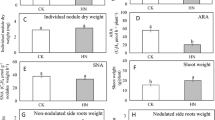Abstract
Thanks to the creation of cold-resistant soybean varieties of the northern ecotype, with a neutral reaction to day length, it became possible to advance its production in the northwest direction. The ability of soybeans to form an effective symbiosis with nodule bacteria determines its environmental-forming role in adaptive agriculture. In 2017–2019 seven varieties and two lines of soybeans have been studied in the field. The varieties Swapa, Lancetnaya, and Krasivaya Mecha have been studied for seven years. The following analyzes were carried out: registration of the above-ground mass and grain yield, the number and weight of nodules, nitrogen removal with the above-ground mass; calculation of the amount of fixed nitrogen in the air using the Hopkins–Peters coefficient; nitrogen content was determined by the Kjeldahl method. The symbiotic system of soybeans develops before the beans are filled, keeping nitrogen-fixing activity at a high level. In arid, unfavorable conditions for the symbiotic system, the number of nodules decreases compared with wet years by 39%, the weight of nodules—by 21%, and the weight of 1 nodule, on the contrary, increases by 68%. The close relationship between the productivity of soybeans and symbiotic indicators is confirmed by the values of the correlation coefficient at the medium and high levels r = 0.4–08. Under conditions of excess moisture, the intensive growth of nodules leads to competition with the generative organs for the distribution of assimilates, as evidenced by the negative correlation between the grain yield and the number and weight of nodules at the level r = −0.623 to −0.751. A positive correlation r = 0.655–0.735 was established between the nitrogen content in leaves and nodules in the budding phase. Over the years of research, the removal of nitrogen with the aboveground mass in soybean varieties varied in the budding phase from 41 to 200 mg/plant, in the filling of beans from 277 to 498 mg/plant; the amount of fixed nitrogen during the budding period was 27–130 mg/plant, in the filling of beans 180–324 mg/plant, depending on the variety and conditions of the year.
Access this chapter
Tax calculation will be finalised at checkout
Purchases are for personal use only
Similar content being viewed by others
References
Denison RF, Toby E, Kiers EW (2004) Why are most rhizobia beneficial to their plant hosts, rather than parasitic? Microb Infect 6(13):1235–1239. https://doi.org/10.1016/j.micinf.2004.08.005
Golovina EV, Zotikov VI (2019) Production process and adaptive responses to abiotic factors of soybean varieties of the northern ecotype in the conditions of the Central Black Earth region of the Russian Federation. Kartush Publishing House, Orel, p 318
Hardy RWF (1977) Rate-limiting steps in biological photoproductivity. Genetic engineering for nitrogen fixation. In: Hollender AN (ed) Basic life science, vol 9, pp 401–408
Methodology for conducting field agrotechnical experiments with oilseeds (2010) Krasnodar, p 327
Nekrasov AYu (2020) Soybeans: sources from the VIR collection of genetic resources. Proc Appl Bot Genet Breed 181(1):48–52
Peoples MB, Brockwell J, Herridge DF (2009) The contribution of nitrogen-fixing crop legumes to the productivity of agricultural systems. Symbiosis 48(1–3):1–17. https://doi.org/10.1007/bf03179980
Posypanov GS (1991) Methods for studying the biological fixation of nitrogen in the air. In: Handbook. “Agropromizdat”, Moscow, p 300
Provorov NA, Onishchuk OP (2019) Ecological and genetic foundations for the design of highly efficient nitrogen-fixing microbial-plant symbiosis. Ecol Genet 17(1):11–18
Seferova IV, Perchuk IN, Boiko AP (2020) The results of the study of collecting samples of soybeans at the Adler experimental station VIR in 2016–2018. Zernobobovye krupyanye kul’tury [Legumes Groat Crops] 3(35):51–57
Til’ba VA (2012) The role of symbiotic nitrogen fixation in increasing the photosynthetic productivity of soybeans. RAAS Rep 5:16–18
Author information
Authors and Affiliations
Editor information
Editors and Affiliations
Rights and permissions
Copyright information
© 2022 The Author(s), under exclusive license to Springer Nature Switzerland AG
About this paper
Cite this paper
Golovina, E.V. (2022). Symbiotic Nitrogen Fixation of Northern Ecotype Soybean Varieties Cultivated in the Conditions of the Central Black Earth Region. In: Popkova, E.G., Polukhin, A.A., Ragulina, J.V. (eds) Towards an Increased Security: Green Innovations, Intellectual Property Protection and Information Security. ISC 2021. Lecture Notes in Networks and Systems, vol 372. Springer, Cham. https://doi.org/10.1007/978-3-030-93155-1_13
Download citation
DOI: https://doi.org/10.1007/978-3-030-93155-1_13
Published:
Publisher Name: Springer, Cham
Print ISBN: 978-3-030-93154-4
Online ISBN: 978-3-030-93155-1
eBook Packages: Intelligent Technologies and RoboticsIntelligent Technologies and Robotics (R0)




